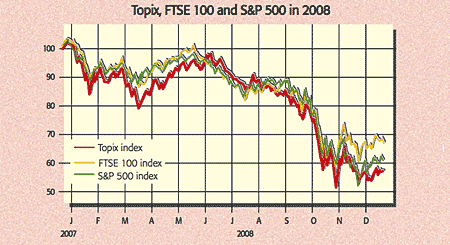
“Bail-out” was the word of the year, according to the compilers of the Merriam-Webster dictionary. It was certainly the word on the minds of investors for most of 2008, raising hopes that were usually quickly dashed.
Back at the start of the year, expectations were high that the bull market would resume promptly. Wall Street was unfazed, says Kopin Tan in Barron’s; a poll of 12 US strategists revealed a consensus forecast of a 10% rise in the S&P 500 over the year. In Britain, Investment Week’s poll of fund managers’ year-end targets for the FTSE 100 ranged from 6,400 to a strikingly specific 7,386. But there was already “concrete evidence that the effects of the credit crunch were spreading to the wider economy”, as Alan Clarke of BNP Paribas put it. As the fundamentals deteriorated, earnings began to fall and the frozen credit markets showed no signs of thawing, stocks continued to tick down.
March saw the first major bail-out of the year: the fifth-largest US investment bank, Bear Stearns, wed to JP Morgan in a shotgun marriage with a dowry from the Fed. Optimists hoped that the events marked a bottom for equities and an easing of the credit crisis, says John Authers in the FT. Markets bounced into May. But soaring commodity prices pushed up inflation, while growth continued to slow. By early July, it was clear that “the gathering chorus of ‘the worst is behind us’ had suddenly gone quiet”, says Lex in the FT. A number of prominent banks failed in America and fears grew about the government-sponsored mortgage giants Fannie Mae and Freddie Mac; at the start of September, the government was forced to assume control of them. This bail-out sparked a rally that Stephanie Pomboy of MacroMavens called “irrational” in Barron’s. She was right: the next week, Lehman Brothers went into bankruptcy and AIG was bailed out by the Fed.
Markets went “completely insane”, says Edmund Shing of BNP Paribas, with record drops amid a flurry of other bank bail-outs and mergers, combined with forced selling by hedge funds. At their October-November lows, the S&P 500 had returned to levels last seen in 1997 and Japan’s Topix was showing no gain since 1983.